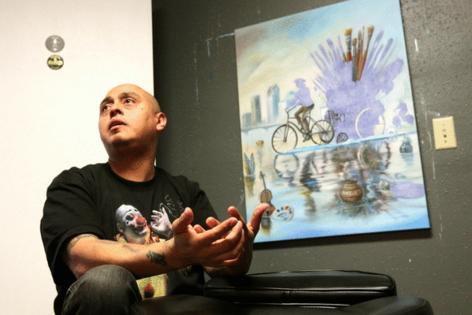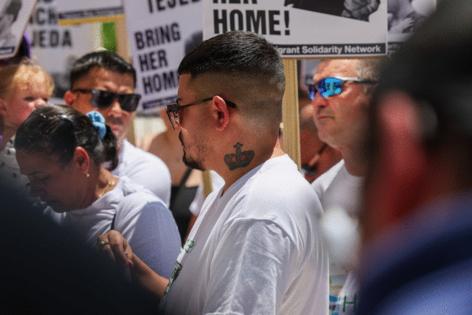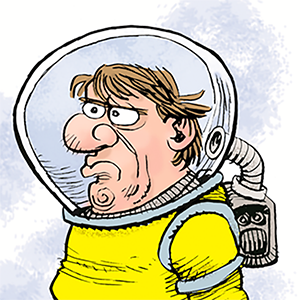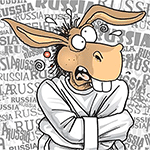Immigration officials link tattoos to gangs. Artists say that's wrong
Published in News & Features
TAMPA, Fla. -- When federal authorities deported 238 immigrants from a Texas prison to El Salvador in March, Neri Alvarado was among them.
The Venezuelan asylum seeker had no criminal record, but immigration officials flagged him as a suspected member of the Tren de Aragua gang based on a tattoo, according to his family. It showed a ribbon with colorful puzzle pieces in it, a widely recognized symbol for autism, and the name of his brother, Neryelson, who is on the spectrum.
On the same flight was Luis Carlos Jose Marcano, a Venezuelan father. He had a second tattoo that immigration authorities found suspicious: a crown on his chest with the phrase “One Life.” His family said Marcano got that tattoo in Venezuela more than eight years ago for a girlfriend he dated while living on Margarita Island, where he is from. The girlfriend had a matching tattoo with the phrase “One Love.”
Family members, advocates and tattoo artists say their deportations show how the U.S. government may be targeting immigrants for their body art, equating symbols of love, faith or personal meaning to signs of gang affiliation.
With links to forced labor, drug trafficking and other violent crimes, Tren de Aragua is classified as a foreign terrorist organization, along with other criminal organizations, including MS-13 in El Salvador and six Mexican cartels.
The designation allowed the Trump administration to invoke the 1798 Alien Enemies Act, an 18th-century wartime declaration, and accelerate its efforts to arrest suspected gang members.
But artists and advocates say that tattoos in and of themselves don’t constitute solid proof that someone is tied to a criminal organization.
Ronna Rísquez, a Venezuelan journalist who wrote a book about Tren de Aragua, said no gang or criminal organization from Venezuela uses a specific tattoo or symbol to identify its members, “simply because none of them operate that way,” she said.
Tattoos are more about fashion and personal choice, she said, not something that sets criminals apart from everyone else.
“People are people, not robots,” Rísquez said.
U.S. Immigration and Customs Enforcement spokesperson Tamara Spicer said in an email that the agency can’t release any information on tattoo indicators “as it is law enforcement sensitive.”
Still, some information about tattoo tracking has trickled out in various court filings.
One guide used by immigration officers is a point-based system to assess whether a suspect belongs to the Tren de Aragua gang, according to a lawsuit the American Civil Liberties Union filed against the Trump administration. The form, called an Alien Enemy Validation Guide, assigns four points if the subject has tattoos indicating membership or loyalty to the criminal organization, and another four points if they wear clothing known to signal allegiance to Tren de Aragua.
Rísquez was struck by the existence of a list of tattoos and how it was being used to remove a person and link them to Tren de Aragua without further evidence. The list includes tattoos of weapons, trains, stars, skulls with gas masks and quotes such as “Hijos de Dios” (Sons of God) and “Real hasta la muerte (Till death).
“That’s what really surprises me,” said Rísquez. “It’s not professional to say that a certain tattoo identifies someone as a criminal. These are tattoos worn by many people.”
Tattoo culture is well established in other criminal organizations, “but those are gangs from other countries,” Rísquez said. The way people think and live also plays a role in how gangs operate and people act, she said.
“It’s impossible to try to identify a group using the same methods every time or to apply the same formula across the board,” said Rísquez.
Néstor Castillo, 36, a professional tattoo artist in Tampa who was born and raised in Los Angeles, said he has many clients who come to his shop asking for tattoos that could appear on the list of designs police believe are linked to criminals.
A star. Michael Jordan’s “Jumpman” logo. A crown popularized by Argentinian soccer Lionel Messi. A rose.
Or a pocket watch, which has been the most requested in the past five years, Castillo said. It’s a way that many Hispanic immigrants mark important moments in their lives, he said, like a wedding, the birth of a child or the passing of a loved one.
“People like it, it’s stylish, and in most cases, they don’t know that police might misinterpret those designs,” said Castillo.
A spider tattoo on the elbow, once often associated with prison culture and a criminal lifestyle, is now considered cool, Castillo said. But these days people should probably be more aware of how certain designs might be misread, he said.
“Now people get it like it’s nothing, and it’s cute. As a tattoo artist, I’ve noticed that too,” Castillo said. “How many pocket watches are out there now? In the gang world, I know there are some symbols but we also know that sometimes tattoos catch on as part of fashion.”
Pedro Jorge Ramirez has a crown tattooed on the left side of his neck. He said he got the tattoo because he liked it and it was trendy. Ramirez, 33, is a Cuban immigrant who became a U.S. citizen 10 years ago.
“I saw it in a magazine and liked it, just like another one I have on my arm, which is the face of a mythical woman,” said Ramirez.
“I’ve got five tattoos on my body that I’ve gotten over the years,” he added. “I’m not afraid because I’m a citizen now, but I don’t like law enforcement linking simple or popular tattoos to gangs.”
Leo Gonzalez, an immigrant community advocate in Tampa, said the government is unfairly accusing people without real evidence.
“They’re using the flimsiest excuse, innocent and often deeply personal tattoos, to strip people of their right to due process and literally disappear them,” he said.
Yusel Quezada, 44, a Cuban body artist in Tampa, said he believes using a list of tattoos to identify or label someone as a member of a gang like Tren de Aragua can be a way to justify an unfair arrest.
While some tattoos may hold deeper meaning for a few, Quezada said most clients choose designs for personal or aesthetic reasons, not criminal ones.
“In the end, it’s a matter of taste, beliefs, and fashion,” he said.
©2025 Tampa Bay Times. Visit at tampabay.com. Distributed by Tribune Content Agency, LLC.










Comments